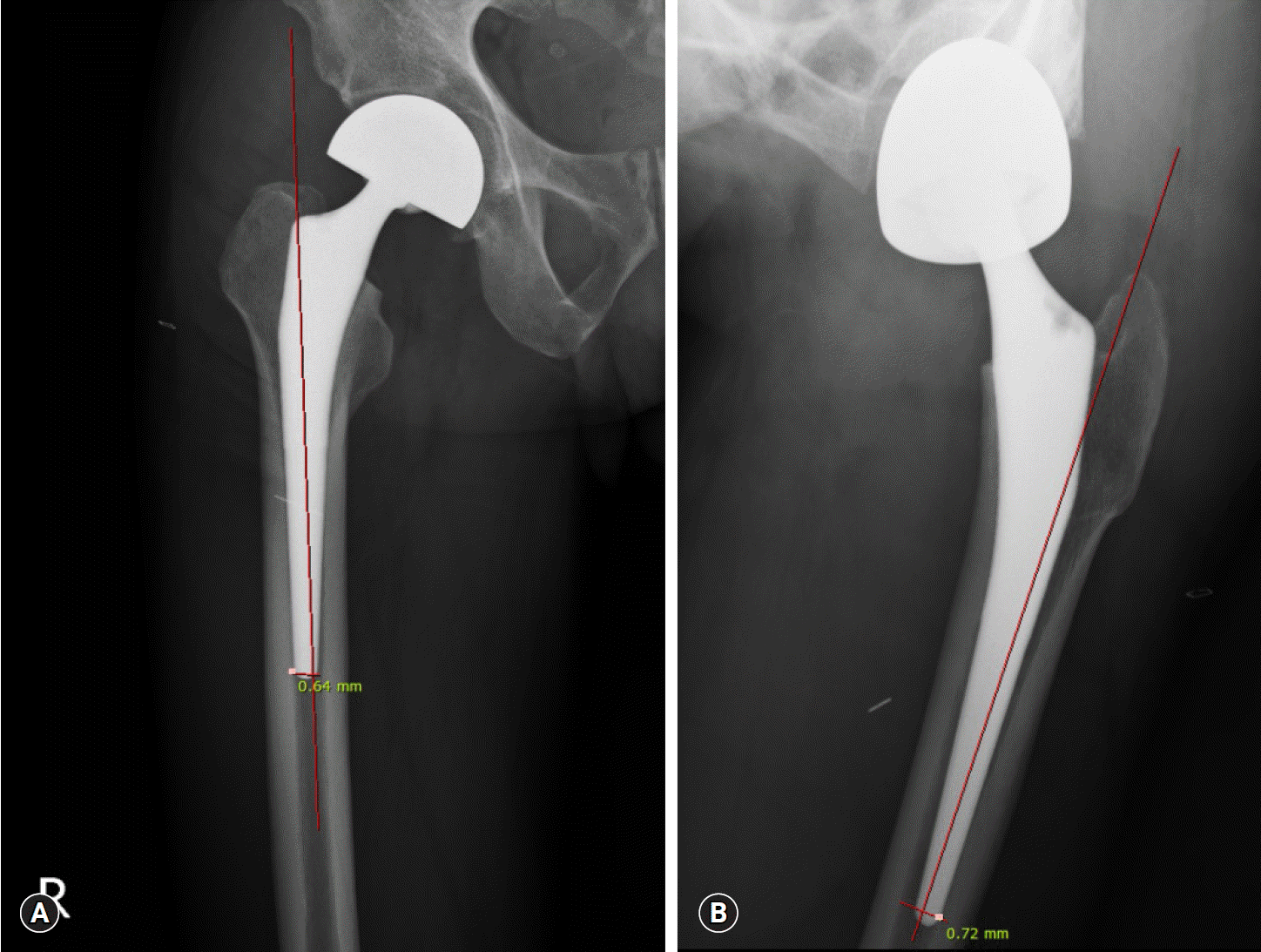1. Barrack RL, Paprosky W, Butler RA, Palafox A, Szuszczewicz E, Myers L. Patients' perception of pain after total hip arthroplasty. J Arthroplasty. 2000; 15:590–6.

2. Domb B, Hostin E, Mont MA, Hungerford DS. Cortical strut grafting for enigmatic thigh pain following total hip arthroplasty. Orthopedics. 2000; 23:21–4.

3. Lavernia C, D'apuzzo M, Hernandez VH, Lee DJ. Patient-perceived outcomes in thigh pain after primary arthroplasty of the hip. Clin Orthop Relat Res. 2005; 441:268–73.

4. Campbell AC, Rorabeck CH, Bourne RB, Chess D, Nott L. Thigh pain after cementless hip arthroplasty. Annoyance or ill omen. J Bone Joint Surg Br. 1992; 74:63–6.

5. Kim YH, Kim VE. Uncemented porous-coated anatomic total hip replacement. Results at six years in a consecutive series. J Bone Joint Surg Br. 1993; 75:6–13.

6. Bourne RB, Rorabeck CH, Patterson JJ, Guerin J. Tapered titanium cementless total hip replacements: a 10- to 13-year followup study. Clin Orthop Relat Res. 2001; 393:112–20.
7. D'Lima DD, Oishi CS, Petersilge WJ, Colwell CW Jr, Walker RH. 100 cemented versus 100 noncemented stems with comparison of 25 matched pairs. Clin Orthop Relat Res. 1998; 348:140–8.
8. Engh CA, Bobyn JD, Glassman AH. Porous-coated hip replacement. The factors governing bone ingrowth, stress shielding, and clinical results. J Bone Joint Surg Br. 1987; 69:45–55.

9. Brown TE, Larson B, Shen F, Moskal JT. Thigh pain after cementless total hip arthroplasty: evaluation and management. J Am Acad Orthop Surg. 2002; 10:385–92.

10. Skinner HB, Curlin FJ. Decreased pain with lower flexural rigidity of uncemented femoral prostheses. Orthopedics. 1990; 13:1223–8.

11. Maloney WJ, Harris WH. Comparison of a hybrid with an uncemented total hip replacement. A retrospective matched-pair study. J Bone Joint Surg Am. 1990; 72:1349–52.

12. Namba RS, Keyak JH, Kim AS, Vu LP, Skinner HB. Cementless implant composition and femoral stress. A finite element analysis. Clin Orthop Relat Res. 1998; 347:261–7.
13. Barrack RL, Jasty M, Bragdon C, Haire T, Harris WH. Thigh pain despite bone ingrowth into uncemented femoral stems. J Bone Joint Surg Br. 1992; 74:507–10.

14. Vresilovic EJ, Hozack WJ, Rothman RH. Incidence of thigh pain after uncemented total hip arthroplasty as a function of femoral stem size. J Arthroplasty. 1996; 11:304–11.

15. Burkart BC, Bourne RB, Rorabeck CH, Kirk PG. Thigh pain in cementless total hip arthroplasty. A comparison of two systems at 2 years' follow-up. Orthop Clin North Am. 1993; 24:645–53.
16. Cooper RR, Milgram JW, Robinson RA. Morphology of the osteon. An electron microscopic study. J Bone Joint Surg Am. 1966; 48:1239–71.
17. Jo WL, Lee YK, Ha YC, Park MS, Lyu SH, Koo KH. Frequency, developing time, intensity, duration, and functional score of thigh pain after cementless total hip arthroplasty. J Arthroplasty. 2016; 31:1279–82.

18. Hailer NP, Garellick G, Kärrholm J. Uncemented and cemented primary total hip arthroplasty in the Swedish Hip Arthroplasty Register. Acta Orthop. 2010; 81:34–41.

19. Hwang SK, Her MS, Joe TY. Total hip arthroplasty with F2L Multineck cementless femoral stem. J Korean Hip Soc. 2007; 19:129–35.

20. Hedley AK, Gruen TA, Borden LS, Hungerford DS, Habermann E, Kenna RV. Two-year follow-up of the PCA noncemented total hip replacement. Hip. 1987; 225–50.
21. von Recum AF. Handbook of biomaterials evaluation: scientific, technical, and clinical testing of implant materials. 2nd ed. Philadelphia: Taylor & Francis;1999.
22. Ivanusic JJ, Sahai V, Mahns DA. The cortical representation of sensory inputs arising from bone. Brain Res. 2009; 1269:47–53.





 PDF
PDF Citation
Citation Print
Print




 XML Download
XML Download